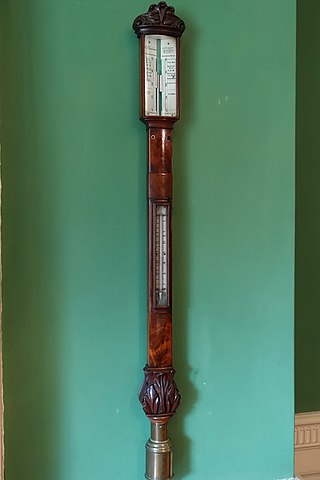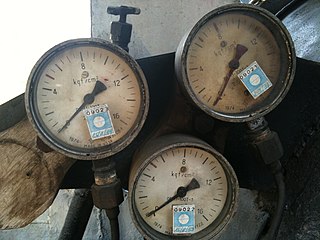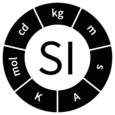
Pressure measurement is the measurement of an applied force by a fluid on a surface. Pressure is typically measured in units of force per unit of surface area. Many techniques have been developed for the measurement of pressure and vacuum. Instruments used to measure and display pressure mechanically are called pressure gauges,vacuum gauges or compound gauges. The widely used Bourdon gauge is a mechanical device, which both measures and indicates and is probably the best known type of gauge.

Pressure is the force applied perpendicular to the surface of an object per unit area over which that force is distributed. Gauge pressure is the pressure relative to the ambient pressure.
Standard temperature and pressure (STP) or Standard conditions for temperature and pressure are various standard sets of conditions for experimental measurements used to allow comparisons to be made between different sets of data. The most used standards are those of the International Union of Pure and Applied Chemistry (IUPAC) and the National Institute of Standards and Technology (NIST), although these are not universally accepted. Other organizations have established a variety of other definitions.
The torr is a unit of pressure based on an absolute scale, defined as exactly 1/760 of a standard atmosphere. Thus one torr is exactly 101325/760 pascals.
Atmospheric pressure, also known as air pressure or barometric pressure, is the pressure within the atmosphere of Earth. The standard atmosphere is a unit of pressure defined as 101,325 Pa (1,013.25 hPa), which is equivalent to 1,013.25 millibars, 760 mm Hg, 29.9212 inches Hg, or 14.696 psi. The atm unit is roughly equivalent to the mean sea-level atmospheric pressure on Earth; that is, the Earth's atmospheric pressure at sea level is approximately 1 atm.
Geopotential height or geopotential altitude is a vertical coordinate referenced to Earth's mean sea level that represents the work involved in lifting one unit of mass over one unit of length through a hypothetical space in which the acceleration of gravity is assumed constant. In SI units, a geopotential height difference of one meter implies the vertical transport of a parcel of one kilogram; adopting the standard gravity value, it corresponds to a constant work or potential energy difference of 9.80665 joules.
Hecto is a decimal unit prefix in the metric system denoting a factor of one hundred. It was adopted as a multiplier in 1795, and comes from the Greek ἑκατόν hekatón, meaning "hundred". In 19th century English it was sometimes spelled "hecato", in line with a puristic opinion by Thomas Young. Its unit symbol as an SI prefix in the International System of Units (SI) is the lower case letter h.

The bar is a metric unit of pressure defined as 100,000 Pa (100 kPa), though not part of the International System of Units (SI). A pressure of 1 bar is slightly less than the current average atmospheric pressure on Earth at sea level. By the barometric formula, 1 bar is roughly the atmospheric pressure on Earth at an altitude of 111 metres at 15 °C.
Given an atmospheric pressure measurement, the pressure altitude is the imputed altitude that the International Standard Atmosphere (ISA) model predicts to have the same pressure as the observed value.
The standard atmosphere is a unit of pressure defined as 101325 Pa. It is sometimes used as a reference pressure or standard pressure. It is approximately equal to Earth's average atmospheric pressure at sea level.

A millimetre of mercury is a manometric unit of pressure, formerly defined as the extra pressure generated by a column of mercury one millimetre high, and currently defined as exactly 133.322387415 pascals or exactly 133.322 pascals. It is denoted mmHg or mm Hg.
The North American High is an impermanent high-pressure area or anticyclone created by a formative process that occurs when cool or cold dry air settles over North America. During summer, it is replaced with an Arctic Low, or a North American Low should it move over continental land.
Inch of mercury is a non-SI unit of measurement for pressure. It is used for barometric pressure in weather reports, refrigeration and aviation in the United States.
A standard cubic foot (scf) is a unit representing the amount of gas (such as natural gas) contained in a volume of one cubic foot at reference temperature and pressure conditions. It is the unit commonly used when following the customary system, a collection of standards set by the National Institute of Standards and Technology. Another unit used for the same purpose is the standard cubic metre (Sm3), derived from SI units, representing the amount of gas contained in a volume of one cubic meter at different reference conditions. The reference conditions depend on the type of gas and differ from other standard temperature and pressure conditions.

A kilogram-force per centimetre square (kgf/cm2), often just kilogram per square centimetre (kg/cm2), or kilopond per centimetre square (kp/cm2) is a deprecated unit of pressure using metric units. It is not a part of the International System of Units (SI), the modern metric system. 1 kgf/cm2 equals 98.0665 kPa (kilopascals). It is also known as a technical atmosphere.

The ambient pressure on an object is the pressure of the surrounding medium, such as a gas or liquid, in contact with the object.

The degree Celsius is the unit of temperature on the Celsius temperature scale, one of two temperature scales used in the International System of Units (SI), the other being the closely related Kelvin scale. The degree Celsius can refer to a specific point on the Celsius temperature scale or to a difference or range between two temperatures. It is named after the Swedish astronomer Anders Celsius (1701–1744), who proposed the first version of it in 1742. The unit was called centigrade in several languages for many years. In 1948, the International Committee for Weights and Measures renamed it to honor Celsius and also to remove confusion with the term for one hundredth of a gradian in some languages. Most countries use this scale.

The pound per square inch or, more accurately, pound-force per square inch, is a unit of measurement of pressure or of stress based on avoirdupois units. It is the pressure resulting from a force with magnitude of one pound-force applied to an area of one square inch. In SI units, 1 psi is approximately 6,895 pascals.

Torricelli's experiment was invented in Pisa in 1643 by the Italian scientist Evangelista Torricelli (1608-1647). The purpose of his experiment is to prove that the source of vacuum comes from atmospheric pressure.

The metresea water (msw) is a metric unit of pressure used in underwater diving. It is defined as one tenth of a bar.












